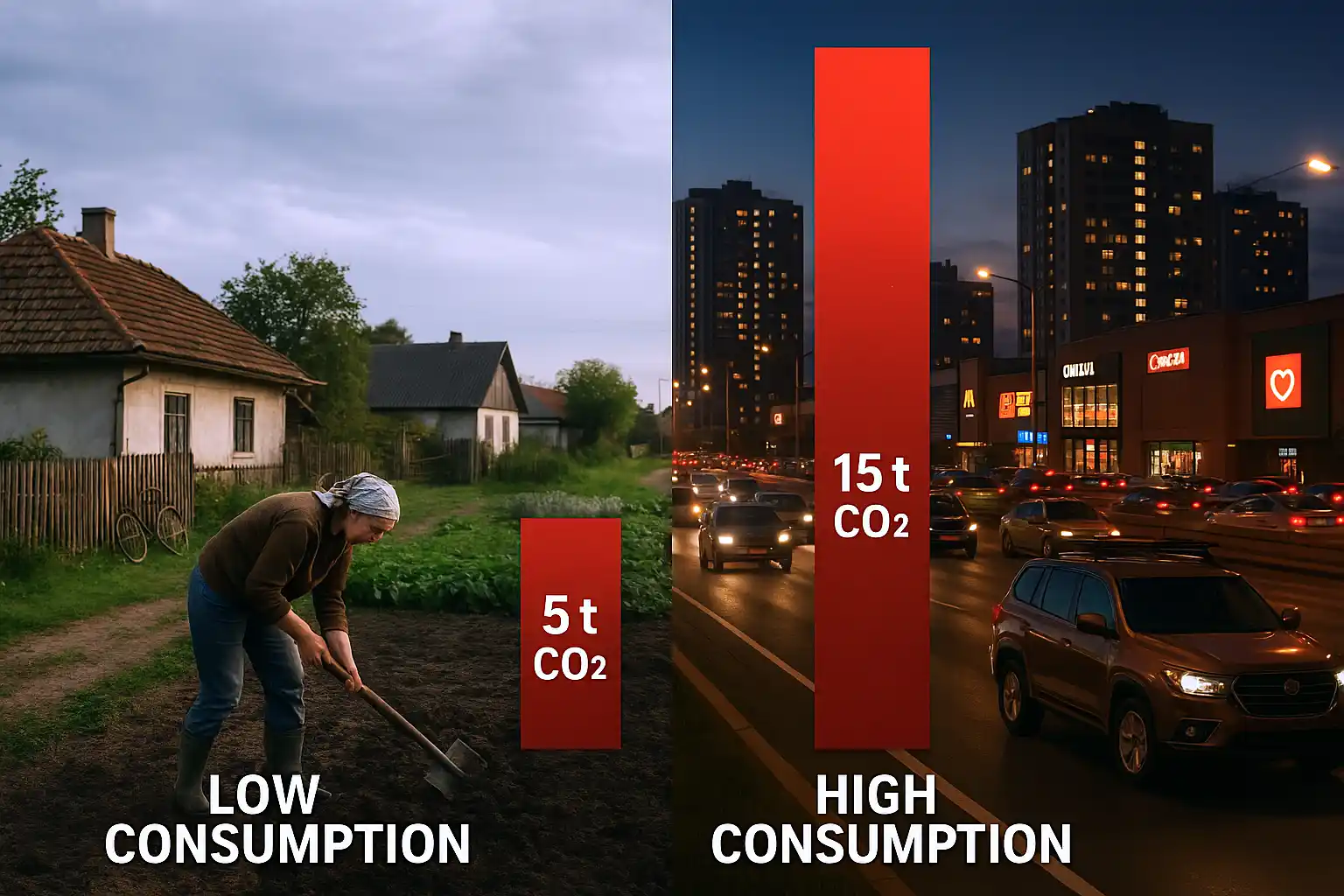Introduction
Carbon Output per Person: Regional Comparisons
-
Eastern Europe: Low estimate: 5 tons of CO2 per person per year High estimate: 8 tons of CO2 per person per year
-
Global South (Africa, India, Middle East, China): Low estimate: 2 tons of CO2 per person per year High estimate: 7 tons of CO2 per person per year
-
Canada: Low estimate: 15 tons of CO2 per person per year High estimate: 20 tons of CO2 per person per year
Immigration Data (2015-2023)
Carbon Output Calculations
A. Carbon Output if Immigrants Stayed in Their Original Regions
Eastern Europe:
-
Low Estimate (5 tons CO2 per person per year): Total Carbon Output: 4,525,048.5 tons of CO2
-
High Estimate (8 tons CO2 per person per year): Total Carbon Output: 7,240,077.6 tons of CO2
Global South:
-
Low Estimate (2 tons CO2 per person per year): Total Carbon Output: 4,223,378.6 tons of CO2
-
High Estimate (7 tons CO2 per person per year): Total Carbon Output: 14,781,825.1 tons of CO2
B. Carbon Output if Immigrants Adopted Canadian Lifestyles
-
Low Estimate (15 tons CO2 per person per year): Total Carbon Output: 45,250,485 tons of CO2
-
High Estimate (20 tons CO2 per person per year): Total Carbon Output: 60,333,980 tons of CO2
Environmental Impact of Immigration: CO2 Savings Analysis
Eastern Europe:
-
Low Estimate: Carbon saved if immigrants stayed in Eastern Europe: 45,250,485 tons (Canada) − 4,525,048.5 tons (Eastern Europe low) = 40,725,436.5 tons of CO2 saved
-
High Estimate: Carbon saved if immigrants stayed in Eastern Europe: 60,333,980 tons (Canada) − 7,240,077.6 tons (Eastern Europe high) = 53,093,902.4 tons of CO2 saved
Global South:
-
Low Estimate: Carbon saved if immigrants stayed in the Global South: 45,250,485 tons (Canada) − 4,223,378.6 tons (Global South low) = 41,027,106.4 tons of CO2 saved
-
High Estimate: Carbon saved if immigrants stayed in the Global South: 60,333,980 tons (Canada) − 14,781,825.1 tons (Global South high) = 45,552,154.9 tons of CO2 saved
Conclusions
-
Environmental Cost of Immigration: Immigration from Eastern Europe and the Global South to Canada significantly increases carbon emissions. If the 3,016,699 immigrants had remained in their home countries between 2015 and 2023, Canada could have saved between 40.7 million and 53.1 million tons of CO2 for Eastern European immigrants and between 41.0 million and 45.5 million tons of CO2 for immigrants from the Global South.
-
Lifestyles and Carbon Emissions: Immigrants coming from lower-emission lifestyles in their home countries adopt higher-consumption Canadian lifestyles, dramatically increasing their carbon footprints. Canada’s car dependency, large homes, and high energy consumption contribute to this spike in carbon output.
-
Policy Implications: Canada’s immigration policy, as it currently stands, accelerates climate change by increasing the carbon footprints of immigrants who transition to a Canadian lifestyle. Canadian immigration policy also imposes a substantial environmental cost. These findings suggest that future immigration policies should incorporate sustainability considerations to mitigate the negative environmental impacts associated with immigration.
Final & Related Considerations
Books for Reference:
-
“The Sixth Extinction: An Unnatural History” by Elizabeth Kolbert – This Pulitzer Prize-winning book discusses human-driven climate change, environmental impact, and how lifestyles in developed countries contribute to emissions, providing context for how increased consumption affects the environment.
-
“Eaarth: Making a Life on a Tough New Planet” by Bill McKibben – This book outlines how high-consumption lifestyles in developed nations significantly contribute to global warming. It can offer insights into the environmental impact of transitions to high-consumption economies, such as when immigrants adopt more carbon-intensive lifestyles.
-
“Collapse: How Societies Choose to Fail or Succeed” by Jared Diamond – This work addresses how societies have historically failed due to environmental mismanagement. It discusses the impact of consumption patterns and can help validate the argument that higher consumption rates accelerate environmental degradation.
-
“The Uninhabitable Earth: Life After Warming” by David Wallace-Wells – This book provides a detailed examination of the extreme environmental consequences of our current consumption patterns, offering relevant information about the impact of industrialized, high-consumption lifestyles on climate change.
Research and Studies:
-
“Immigration, Population Growth, and Environmental Sustainability” (Research by the Centre for Immigration Studies) – This research explores the relationship between immigration and environmental sustainability in developed nations, with a focus on how immigration can increase resource consumption and emissions. It offers concrete data and perspectives that reinforce our argument.
-
“Global Warming of 1.5°C” (IPCC Special Report) – This comprehensive report by the Intergovernmental Panel on Climate Change (IPCC) discusses how different regions contribute to global emissions and the impact of transitioning to more carbon-intensive lifestyles, which aligns with our thesis about immigration and increased carbon footprints.
-
“Environmental Impacts of Population Growth: The Role of Immigration in Canada” (Journal of Population and Sustainability) – This paper directly addresses the environmental implications of population growth due to immigration in Canada, focusing on carbon emissions and resource consumption. It offers empirical data to support our conclusions.
-
Statistics Canada Reports on Immigration and Emissions – Government data from Statistics Canada can validate immigration trends from 2015 to 2023, helping to ensure accuracy in the numerical data related to immigration. This can be cross-referenced with regional and national CO2 emissions reports to ensure consistency with the argument of increased carbon output.




Related Content:
Title: “Unlocking Canada’s Crown Lands: A Path to Economic Revival and National Prosperity” https://x.com/SkillsGapTrain/status/1832992971815305263
Title: “Unpacking the Crisis: How Zoning, Immigration, and the Skills Gap Fuel Canada’s Housing Affordability Issue” https://skillsgaptrainer.com/unpacking-the-crisis-in-canadas-housing/
Title: “Economic Impact of Blocking Resource and Energy Sectors in Canada” https://skillsgaptrainer.com/economic-impact-blocking-resource-energy/
Title: “Enhancing Vehicle Efficiency Through Weight Reduction and Natural Gas Hybrid Systems” https://skillsgaptrainer.com/enhancing-vehicle-efficiency/
Title: “Towards a Sustainable Future: Integrating Hydrogen, CNG, and Electric Vehicles in Modern Transportation” https://skillsgaptrainer.com/towards-a-sustainable-future/
Title: “Safeguarding Existence: The Farmer’s Role in an Era of Smart Cities and AI Dominance” https://skillsgaptrainer.com/safeguarding-existence-the-farmers-role/
Title: “The Impact of Demographic Shifts on National Sovereignty and Stability in Western Nations” https://x.com/SkillsGapTrain/status/1814220033947512923
Title: “Navigating Cultural Clashes: Rethinking Western Europe’s Immigration Focus” https://skillsgaptrainer.com/navigating-cultural-clashes/
Title: “Why Canada is the Greatest Nation on the Planet” https://skillsgaptrainer.com/why-canada-is-the-greatest-nation/
Title: “Unleashing Canada’s Potential: Axing the Barriers to Land and Prosperity” https://skillsgaptrainer.com/unleashing-canadas-potential/
Title: “Is Canada Facing a Religious Arson War?” https://skillsgaptrainer.com/is-canada-facing-a-religious-arson-war/
Title: “From Unity to Division: The Erosion of Christian Values and the Rise of Woke Culture” https://skillsgaptrainer.com/the-erosion-of-christian-values-and-the-rise-of-woke-culture/
Title: “Pierre Poilievre’s Stand Against Carbon Taxation: Unveiling Canada’s Fight Against A Shift in Property Ownership and Investment” https://skillsgaptrainer.com/pierre-poilievres-stand-against-carbon-taxation/
Title: “The Lost Generations: How Canada’s Immigration Policies & HR Failed Millennials and Gen Z” https://skillsgaptrainer.com/the-lost-generations/
Title: “Guarding the Citizens: The Essential Role of Citizenship Ceremonies in Canadian Identity and Authority” https://skillsgaptrainer.com/guarding-the-citizens/
Title: “Balancing Climate Action and Industrial Development: A Multi-National Perspective” https://skillsgaptrainer.com/balancing-climate-action/
Title: “From Unity to Division: The Erosion of Christian Values and the Rise of Woke Culture” https://skillsgaptrainer.com/the-erosion-of-christian-values-and-the-rise-of-woke-culture/
To see our Donate Page, click https://skillsgaptrainer.com/donate
To see our YouTube Channel, click https://www.youtube.com/@skillsgaptrainer
